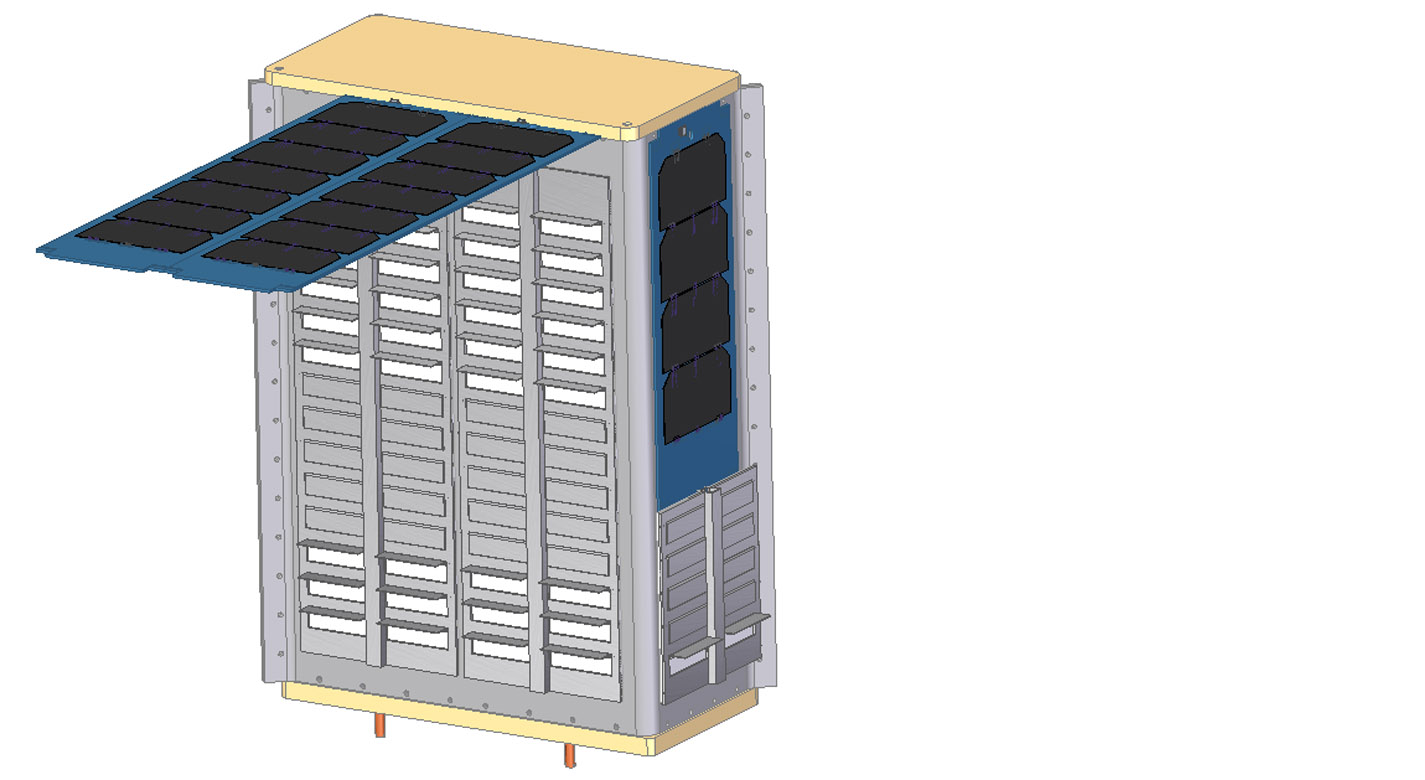CubeSat Form Factor Thermal Control Louvers
aerospace
CubeSat Form Factor Thermal Control Louvers (GSC-TOPS-40)
Passive thermal cooling for CubeSats
Overview
As small spacecraft become a part of NASAs repertoire of missions, one reoccurring theme is an increased need for thermal control as power budgets increase and tight instrument temperature tolerances are introduced on smaller platforms. Until now CubeSats have not needed thermal control outside of resistive heaters due to the low power and short lifespan of most CubeSat missions. However, in the past few years CubeSat solar panels have been developed by private companies which can produce up to 80W of power for a 3U (30X10X10 cm) spacecraft. Now, CubeSat and small satellite missions are being proposed which rise to meet this new technological envelope, with high power instruments and multiple months or years of mission life. Therefore it is critical that a thermal control system be designed for small spacecraft missions.
The CubeSat Form Factor Thermal Control Louvers use passive thermal control to significantly improve the internal thermal stability of small spacecraft, creating a difference of several watts in dissipated heat between open and closed louvers.
The Technology
Thermal control of small spacecraft, including CubeSats, is a challenge for the next era of NASA spaceflight. Science objectives and components will still require strict thermal control while smaller volumes will inherently absorb and shed heat more quickly than a larger body. Thus, game-changing technologies must be developed to stabilize the thermal environment inside of small spacecraft.
The CubeSat louver assembly of the present invention is based upon the proven designs of full-sized louvers for large spacecraft. Internal spacecraft components are thermally coupled to the side of the spacecraft. Bimetallic springs serve as a passive control mechanism for opening and closing flaps. As the spacecraft heats up the springs expand due to the difference in thermal expansion rates of their two fused metals (hence bimetallic). This opens the flaps, changing the thermal radiation properties of the exterior surface. As the spacecraft cools the flaps close and return the exterior surface to the previous emissivity. These temperature-driven adjustments create a more stable thermal environment for components.
The power dissipated via the thermal louvers shows a substantial difference between fully closed and fully open louvers at the high temperatures significant for electrical components.


Benefits
- Provides passive actuation of flaps via bimetallic springs, requiring no power for thermal control
- Allows adaptability while still maintaining a standard form factor; the modular design can be produced in large quantities and swapped into various sized plates to tailor the thermal control to each spacecraft's needs
- Built in redundancy is inherent in the multiple bi-metallic spring design, so if one spring fails then only one pair of flaps will be inactive
- Implements additive manufacturing to create lightweight, easily reproduceable flaps
Applications
- Designers and manufacturers of CubeSats / SmallSats in academia, government, and industry could benefit from this tool.
|
Tags:
|
Similar Results

Silicon Oxide Coated Aluminized Polyimide Film Radiator Coating
The SiOx Coated Aluminized Polyimide Film Radiator Coating uses all the exposed surfaces on the six sides of a CubeSat as radiators. All the internal components are thermally coupled to the radiators. Waste heat from the internal components is transferred by conduction to the radiators through its aluminum structure or frame. SiOx thin film coated aluminized polyimide film is used as the radiator coating. Its total thickness is approximately 0.05 mm, which is predominately the polyimide film thickness. Polyimide film is known commercially as Kapton. The coating is bonded to the CubeSat exterior by using an acrylic transfer adhesive.
SiOx Coated Aluminized Polyimide Film Radiator Coatings absorptance and emittance can be tailored to meet the component thermal requirements by altering the SiOx thickness. Since the SiOx is a thin film, altering its thickness has no significant effect on the total thickness of the radiator coating. An indium tin oxide (ITO) thin film can be added to make the coating conductive, if needed, without affecting the absorptance or emittance. This coating, with or without ITO, can be used for various CubeSat applications. By tailoring the absorptance and emittance of this coating, external MLI blankets and active heater control are eliminated. The thermal connection between heat generating components and the battery eliminates the need for a battery heater.

Diminutive Assembly for Nanosatellite deploYables (DANY)
SmallSat designers seek to employ restraints and release mechanisms of minimal size and weight, often placing each on the outside of the SmallSat structure. Surprisingly, "fishing line" (released via burn through) is often used to secure and release deployables. Vibrations and forces generated during launch can stretch the fishing line, thus allowing these precious deployables to become damaged or otherwise not release properly later on. While these small sats are less expensive than their larger counterparts, satellite owners must minimize the chance that deployables are damaged or that deployment is unsuccessful.
Five years ago, engineers at NASA GSFC faced these SmallSat deployment challenges and knew a better way must exist to prevent equipment damage and ensure successful release. Investigating a host of designs to minimize size, weight, and cost while maximizing communication and mechanical reliability, NASA's engineers created DANY (the Diminutive Assembly for Nanosatellite deploYables). NASA's DANY technology uses spring-loaded metal pins, a reliable burn-through mechanism, efficient bracketing, and a circuit board - all within a 3.0" x 1.3" x 0.2" volume (smaller than a stack of 10 business cards) - to reliably stow and release deployables on command. Using DANY, stowed deployables are securely fastened using the spring-loaded locking pins. Upon receiving a deployment signal, a plastic restraining link is burned through which allows the spring-loaded pins to release the deployable and simultaneously trigger a switch to signal a successful deployment event.

CubeSat Compatible High Resolution Thermal Infrared Imager
This dual band infrared imaging system is capable of spatial resolution of 60 m from orbit and earth observing expected NEDT less than 0.2o C. It is designed to fit within the top two-thirds of a 3U CubeSat envelope, installed on the International Space Station, or deployed on other orbiting or airborne platforms. This infrared imaging system will utilize a newly conceived strained-layer superlattice GaSb/InAs broadband detector array cooled to 60 K by a miniature mechanical cryocooler. The camera is controlled by a sensor chip assembly consisting of a newly developed 25 m pitch, 640 x 512 pixel.

Portable Compact Thermionic Power Cell
This compact thermionic cell (CTI) technology can be manufactured efficiently and economically using existing semiconductor fabrication technology. Its design consists of a top electron collector, separated by a vacuum gap from an electron emitter adjacent to the heat source, a thin plate of 238Pu enclosed by a thin-film insulator to protect the emitter and collector layers from overheating by the 238Pu. For a smart phone battery size, the invented compact thermionic (CTI) cell requires about 5 g maximum of 238Pu. Such small quantities are more readily available and producible, and could be reused for recycling when the CTI cell is dismantled. The emitter surface is topologically modified to have array of spikes, achievable using current semiconductor microfabrication technology. Various other geometries of emitter plates may also be used, such as an array of ridges. The smaller the emitter tips, the higher the voltage concentration.

Dellingr 6U CubeSat
A NASA team gave itself just one year to develop, test and integrate a CubeSat that could reliably and easily accommodate agency-class science investigations and technology demonstrations at a lower cost. The CubeSat known as Dellingr, a name derived from the god of the dawn in Norse mythology will carry three heliophysics-related payloads. It doubles the payload capability of the ubiquitous and proven three-unit, or 3U, CubeSat pioneered by the California Polytechnic Institute in 1999 primarily for the university community.
The need for such a platform, which measures about 12 inches long, nearly 8 inches wide and 4 inches high, was for more cost-effective approaches to achieve compelling Earth and space science.
Disadvantages of the 3U size include more constraints on volume and power. Furthermore, some studies suggest that previous CubeSats failed 40 percent of the time. By doubling the platform's girth, increasing its power capacity, and employing novel processes to increase its on-orbit reliability, the team believes it will have created a platform capable of carrying out more robust missions for science.
Once successfully demonstrated, the team says it will make the platform's design implemented with low-cost, commercial off-the-shelf parts available to any U.S. organization interested in using it.



